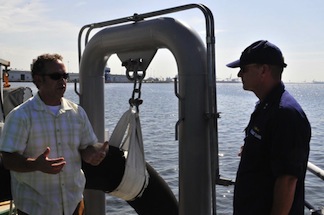The following is the text of a news release from Coast Guard Maritime Commons:
(WASHINGTON) — As independent labs across the U.S. continue to test ballast water management systems (BWMS) for U.S. type approval, the U.S. Coast Guard remains fully invested in the process and future of these systems and looks forward to the approval of a U.S. type-approved system that meets the standards of the ballast water regulations.
Rear Adm. Paul Thomas, Coast Guard assistant commandant for prevention policy, Jeff Lantz, director of commercial regulations and standards, and other members of their staffs recently visited the Marine Environmental Resource Center (MERC), located in Baltimore, in order to see the testing environment, gain insight into the testing procedures and protocols, and speak with the scientists about ballast water management system testing challenges.
MERC provides testing facilities, expertise and decision tools for key environmental issues that face the international maritime industry. Its partners include the U.S. Maritime Administration, Smithsonian Institution and the University of Maryland.
Leading this initiative is Mario Tamburri, a professor at the University of Maryland with more than 15 years of expertise in researching the spread of invasive species through ballast water.
MERC operates a barge based in Baltimore Harbor that allows Tamburri and his team the flexibility to move to different locations in order to get different data from various environments. Tamburri said MERC is currently focused on conducting land-based and shipboard testing for type approval of ballast water management systems and can test two systems per year.
“We want to get data,” he said.
There are over 60 manufacturers of foreign type-approved ballast water management systems, and many are pursing U.S. type approval by utilizing Coast Guard accepted labs, such as MERC, to test their systems in accordance with the regulations and ETV protocol.
Onboard MERC, the system begins with a flexible hose that can be tailored to take in water from different depths, based on various environmental aspects. The goal is to get as many organisms as possible to test the ballast water management system.
By utilizing this method, “we’ve never had to augment biology,” Tamburri said.
With this visit, the Coast Guard was able to gain an insight from current testing facilities and continued to monitor the progression toward a U.S. type-approved ballast water management system.
“We understand the challenges faced by the various types of treatment systems, and we continue to have discussions with our five designated Independent Labs to capture the lessons learned,” said Thomas. “Although the regulations and test protocol are not perfect, they are the best available type-approval test requirements, and we’ll continue to work with our stakeholders to improve the next generation of testing regulations and protocols.”

